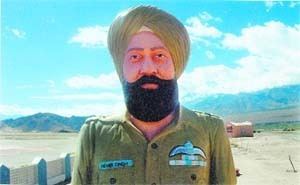Nickname(s) Mehar Baba Role Pilot Name Mehar Singh | ||
 | ||
Born 20 March 1915Lyallpur, Punjab, British India ( 1915-03-20 ) Died March 11, 1952, Delhi, New Delhi | ||
Air commodore mehar singh mvc dso
Air Commodore Mehar Singh, MVC, DSO, (20 March 1915–11 March 1952) was a fighter pilot, known as one of the persons who gave the Indian Air Force (IAF) its ethos of selfless service. He is affectionately known as 'Mehar Baba', a sobriquet coined by Aspy Engineer, in IAF circles.
Contents
- Air commodore mehar singh mvc dso
- Early life and career
- Awards
- Resignation and life after IAF
- Death
- References

Early life and career
Mehar Singh was born on 20 March 1915 at Lyallpur (now Faisalabad in Pakistan). He was selected for the Royal Air Force College Cranwell (RAFC), England in 1933 while he was in the final year of B.Sc and joined in 1934. He performed exceedingly well at Cranwell which impressed college authorities.
Air Vice Marshall H. M. Grave, Commandant, RAFC wrote of Singh:
Singh was commissioned as a Pilot Officer in August 1936 and posted to No.1 Squadron, then the only squadron in the Royal Air Force (RAF). It was raised on 1 April 1933 at Karachi with four Westland Wapiti aircraft. The Indian element consisted of six officers and nine technicians then known as ‘Hawai Sepoys’. Singh was amongst the first six pioneering officers who joined the squadron. Flight Lieutenant C. A. Bouchier, DFC, an officer of the Royal Air Force (RAF) was the first Commanding officer of the Squadron.
Singh won the awe and adulation of both seniors and men under him during his association with the Indian Air Force. Air Marshal Asghar Khan, an officer under Singh in the pre-partition Royal Indian Air Force who later became the Chief of Air Staff of the Pakistan Air Force, once said:
In 1937, Flying Officer Singh and his air gunner Ghulam Ali were attacking a tribal post at Shaider, when his fuel tank was hit by rifle fire. He had to crash-land the Wapiti in rocky terrain and had to evade the hostile tribesman searching for them to make it back to the Army lines. It was late in the afternoon, Singh and Ali extricated the Lewis gun and took refuge in a cave as hostile tribesmen searched for them. At nightfall, the airmen walked back without maps, evading the hostiles and returned safely.
Under the leadership of Singh, Squadron No 6 with its Hawker Hurricane aircraft, came to be known as 'The Eyes of the 14th Army', which was commanded by General William Slim. After the war, Slim recorded:
Lieutenant General Harwant Singh (Retd.) said:
Wing Commander Singh was the first pilot to land at Poonch Airport and also the first pilot to land at Poonch at night, with the help of oil lamps. He did so without any landing aids. For his work in Arakan Singh was awarded a Distinguished Service Order (DSO) in March 1944, the only officer of the Indian Air Force to have won this award.
Awards
Resignation and life after IAF
Singh resigned from the IAF on 27 September 1948 over differences with some senior officers on service matters and instead of getting involved in controversy. After his retirement, Singh was personal adviser to the Maharaja of Patiala Yadavindra Singh, the Rajpramukh of Patiala and East Punjab States Union (PEPSU). When the gallantry awards were instituted, the Maha Vir Chakra (MVC) was conferred upon Singh.
Death
On the night of 16 March 1952, an aircraft Singh was flying from Jammu to New Delhi was caught in a storm, killing Singh.
